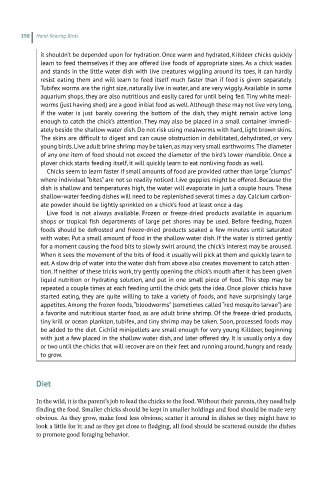Page 406 - Hand rearing birds second
P. 406
398 Hand-Rearing Birds
it shouldn’t be depended upon for hydration. Once warm and hydrated, Killdeer chicks quickly
learn to feed themselves if they are offered live foods of appropriate sizes. As a chick wades
and stands in the little water dish with live creatures wiggling around its toes, it can hardly
resist eating them and will learn to feed itself much faster than if food is given separately.
Tubifex worms are the right size, naturally live in water, and are very wiggly. Available in some
aquarium shops, they are also nutritious and easily cared for until being fed. Tiny white meal-
worms (just having shed) are a good initial food as well. Although these may not live very long,
if the water is just barely covering the bottom of the dish, they might remain active long
enough to catch the chick’s attention. They may also be placed in a small container immedi-
ately beside the shallow water dish. Do not risk using mealworms with hard, light brown skins.
The skins are difficult to digest and can cause obstruction in debilitated, dehydrated, or very
young birds. Live adult brine shrimp may be taken, as may very small earthworms. The diameter
of any one item of food should not exceed the diameter of the bird’s lower mandible. Once a
plover chick starts feeding itself, it will quickly learn to eat nonliving foods as well.
Chicks seem to learn faster if small amounts of food are provided rather than large “clumps”
where individual “bites” are not so readily noticed. Live guppies might be offered. Because the
dish is shallow and temperatures high, the water will evaporate in just a couple hours. These
shallow-water feeding dishes will need to be replenished several times a day. Calcium carbon-
ate powder should be lightly sprinkled on a chick’s food at least once a day.
Live food is not always available. Frozen or freeze-dried products available in aquarium
shops or tropical fish departments of large pet shores may be used. Before feeding, frozen
foods should be defrosted and freeze-dried products soaked a few minutes until saturated
with water. Put a small amount of food in the shallow water dish. If the water is stirred gently
for a moment causing the food bits to slowly swirl around, the chick’s interest may be aroused.
When it sees the movement of the bits of food it usually will pick at them and quickly learn to
eat. A slow drip of water into the water dish from above also creates movement to catch atten-
tion. If neither of these tricks work, try gently opening the chick’s mouth after it has been given
liquid nutrition or hydrating solution, and put in one small piece of food. This step may be
repeated a couple times at each feeding until the chick gets the idea. Once plover chicks have
started eating, they are quite willing to take a variety of foods, and have surprisingly large
appetites. Among the frozen foods, “bloodworms” (sometimes called “red mosquito larvae”) are
a favorite and nutritious starter food, as are adult brine shrimp. Of the freeze-dried products,
tiny krill or ocean plankton, tubifex, and tiny shrimp may be taken. Soon, processed foods may
be added to the diet. Cichlid minipellets are small enough for very young Killdeer, beginning
with just a few placed in the shallow water dish, and later offered dry. It is usually only a day
or two until the chicks that will recover are on their feet and running around, hungry and ready
to grow.
Diet
In the wild, it is the parent’s job to lead the chicks to the food. Without their parents, they need help
finding the food. Smaller chicks should be kept in smaller holdings and food should be made very
obvious. As they grow, make food less obvious; scatter it around in dishes so they might have to
look a little for it; and as they get close to fledging, all food should be scattered outside the dishes
to promote good foraging behavior.

